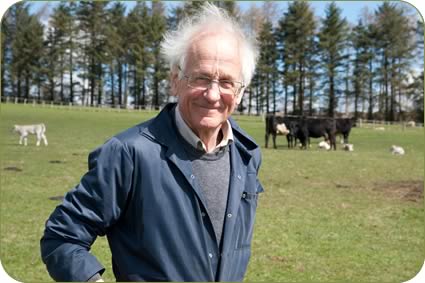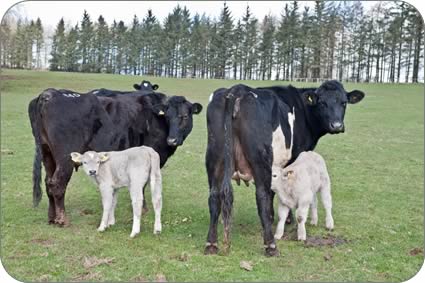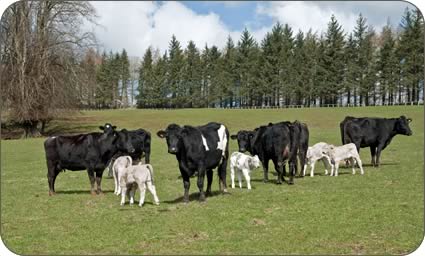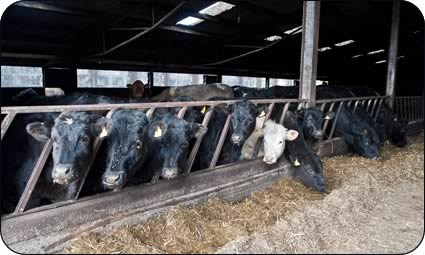Jennifer MacKenzie is an agricultural photo journalist with almost 30 year's experience. Operating from her base in Cumbria, Jennifer undertakes mainly industry-related freelance writing and photography.
Health Planning Increases Productivity
Herd productivity has been improved over recent years by as much as 15%
since farm health planning was introduced almost 20 years ago at Greystoke
Castle Farms, near Penrith.
David Lawton, a former hill farming lecturer at Newton Rigg College, has run the day to day management of the 2,300 acre all grass and virtually all SDA beef and sheep unit for the last 25 years as part of a partnership with the Howard family who own Greystoke Castle and the estate. The farm was one of six in the Penrith area taken in by the British Grassland summer meeting in June (24-26).
 |
David Lawton |
The 280 cow herd is predominantly black Limousin crosses with some British Blue and Charolais genetics. Heifers are inseminated to the Limousin and older cows are run with the farm's seven strong pedigree Charolais bull team or AId with Charolais semen.
sA New Zealand type system helps to exploit the farm’s economy of scale, while at the same time producing high quality forward stores commanding significantly higher than average prices.
Key to the success of the beef operation is that the majority of cows calve within 10 weeks - heifers begin calving two weeks earlier and total production averages 94 % of calves reared from scanning to marketing with 6% geld cows a year. The herd's calving index is kept under strict control and is running at 370.
The spring calving herd is able to maximise grass, milk and creep and three quarters of the crop achieve weights of 320kg to 350kg at seven months old when they are sold on one day at Longtown Mart where they invariably feature in the day' s top 5% of trade.
 |
Cows and spring born calves |
The remainder are overwintered in the unit's limited accommodation and sold in February at an average 359kg.
"It's all about bull power - we run one bull to 30 cows. I don't believe you will achieve a tight calving pattern by running a bull with more than 30 cows. Semen is collected from the best bulls to further increase their influence in the herd. A group of 45 cows is AId which frees up one bull to move on to the next batch of calves. AId cows have an average conception rate of 60-70%," said David.
All heifers are synchronised for AI with vets Frame and Swift, Penrith. CIDR cattle progesterone inserts for oestrus synchronisation are used on second Monday in May and left for seven days. The CIDRs are then removed and the heifers are injected with Estrumate and are inseminated within 48 to 72 hours with a conception rate of 70%.
The small number of barren females are kept on a maintenance diet over the winter and served by AI when the other cattle are calving, to calve down the following March.
Working with Frame and Swift, a herd assessment is made on an annual basis and targets schedules.
Bulls are selected for conformation and from within the breed's top 5% on Breedplan recorded performance for muscle depth, 400 day weight and calving ease.
David believes the Charolais is the most suitable for producing the type of store cattle for today’s market and the terminal sire’s high growth rate potential and quiet temperament has suited the system at Greystoke Castle Farm.
The spring calving regime is designed to enable calves to maximise potential from milk and grass as well as purchased ad lib feed fed to achieve an average 1.4kg daily liveweight gain.
 |
Cows and spring born calves |
Variable costs are minimised wherever possible, but David believes in making investments in creep feed to achieve a high output with the calves receiving 3kg of creep a day.
Great emphasis is placed on cows gaining body condition at grass, to improve fertility. They are housed in cubicles or on slatted accommodation, to make slurry management easier in late October with as big a body condition score as possible and then introduced to a winter feeding regime of 26kg of silage and 4kg chopped straw per head per day, plus minerals - a simple but effective system primarily using the farm’s resources.
The TMR is designed to manage cow body condition to enable cows to calve at a body condition score of 2.5 to 3. The TMR at housing has also improved fertility.
Allowing cows to lose body condition during the housed period has enabled big savings on silage costs - with a total of 50 acres previously allocated for silage available for summer grazing.
This strategy has released around 16 hectares (40 acres) of grazing land which would have previously been closed up for silage making. The savings contribute towards the cost of buying in straw and make easier management of grazing livestock throughout the summer.
Winter housed cows with calves at foot are fed the same basic ration as the spring calvers plus an extra 18-20kg of silage to maintain quality milk production and body condition score.
Cows are stocked at one livestock unit per hectare, plus calves, and each unit of staff - the farm employs one cowman, two shepherds and a general farm worker who is also a capable stockman - is required to manage 180 livestock units.
Mr Lawton says he learned many years ago that one cow to 8-10 sheep was the ideal ratio for most upland farms, and this has turned out to be the case at Greystoke Castle.
Ploughing and reseeding were common practice until 17 years ago, but the expense and problems with stones has now made reseeding only an absolute necessity which helps avoid poaching.
“The farm’s land is tremendously fertile red soil which we give generous applications of slurry, which includes some from a neighbouring pig farm,” says Mr Lawton.
The silage fields are shut up in early May and just one cut is taken – usually at the end of June/early July.
 |
Heifers |
Lambs from the 1,400 ewe Mule flock and 850 Swaledales crossed to breed replacements are weaned in August and grazing is in demand. The farm saves both labour and machinery costs as one of three members of a local silage syndicate, an arrangement which has worked well for several years.
Most of the suckler herd replacements have traditionally been bought-in from known sources.
Around 150 stores are weaned off their mothers and leave the farm on the same day, usually during October. Later-born animals are given silage and creep, left on their dams until January and sold as forward stores the following month.
All store cattle and finished lambs are sold through Cumberland and Dumfriesshire Farmers’ Mart at Longtown, where David is a director. Of last year’s calf crop 155 sold one one day to £920 and averaged £768 selling to regular purchasers.
This policy of marketing two-thirds of the store cattle at one sale might be viewed as high risk, but Mr Lawton insists the rearing period is carefully managed.
Average weights are around 320-350kgs at seven months for bullocks, with heifers slightly lighter.

